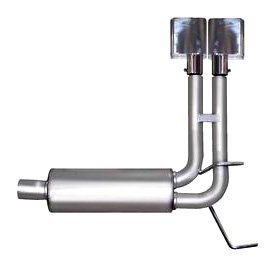Ignition System
![Exhaust System]()
To have an efficient running engine, there must be the correct amount of fuel mixed with the correct amount of air. These must be present in a sealed container and shocked by right amount of heat at the correct time. With total efficiency, the engine would release extremely low amount of pollutants in its exhaust. Although total efficiency is not possible at this time, late-model engines emit very low amount of pollutants, thanks to emission control device.
To have efficient engines, the basic engine needs highly efficient, fuel, and emission control systems. Although there are many different designs of these systems, the designs are similar in operation.
1. FUNCTION
The function of the ignition system is to produce a spark in the engine
cylinder towards the end of the compression stroke. In a four-stroke engine,
a spark should occur in each cylinder after two revolutions of the crankshaft,
whereas in a two-stroke engine a spark in each cylinder is required every
revolution of the crankshaft. Thus, for instance, in a 6-cylinder 4 stroke engine
running at 5000 r.p.m., the number of sparks required per minute will be
15000 and these have to be timed very accurately.
2. REQUIREMENTS OF AN IGNITION SYSTEM
1. Spark at the plug electrodes must be regular and synchronously timed with respect to the cylinder-piston position at all speeds and loads on the engine.
2. The spark should be sufficiently strong so as to start ignition of the charge. Since lean air fuel mixtures are less conductive, they require higher ignition voltages. Thus on modern emission- controlled engines that use lean mixtures, higher-voltage ignition system is required. Moreover, due to higher secondary voltage in these systems, it becomes necessary to increase the electrical insulation.
3. It should be light and compact.
4. The system must be easy to maintain.
5. It should be adaptable to mass production.
6. It must not cause radio interference.
3. TYPES OF IGNITION SYSTEM
A battery of 12 volts is generally employed. However, a very high voltage surge (of up to 25,000 volts in modern engines) is required for ignition purposes. The actual high voltage at which the spark occurs is called breakdown voltage and it depends upon so many factors, viz., the gap, polarity and condition of plug electrodes, condition of plug insulation, moisture on the distributor cap and spark plugs and pressure, temperature and type of mixture in the combustion chamber. Used spark plugs may require fairly higher voltage to fire than the new plugs because of increase in the gap and rounding off of the centre electrode. In a given engine the highest ignition voltage is required during part-throttle acceleration because the fuel system is then supplying a lean mixture with increased combustion pressures. To produce such a high voltage, a special ignition system has to be employed.
Two types of conventional ignition systems (called point type ignition systems) are in current use, viz., the 'battery ignition system' and the 'magneto ignition system'. However, both these systems have the major drawbacks of inertia of mechanical components like contact breaker and insufficient dwell period to build up adequate coil field at high engine speeds. Though for a long time, both these systems have been in use and giving satisfactory performance, yet since mid seventees, these are being fast replaced by 'electronic ignition systems'. Point-type and the solid-state (electronic) ignition systems operate in the same way except that they differ in the way the primary current is stopped and restarted.
The conventional point- type systems will be discussed in detail in this chapter, one of the requirements for an efficient engine is the correct amount of heat shock, delivered at the right time. This requirement is the responsibility of the ignition system. The ignition system supplies properly timed high-voltage surges to the spark plugs. These voltage surges cause combustion inside the cylinder. The ignition system must create a spark or current flow across each pair of spark plug electrodes at the proper instant, under all engine operating conditions.
This may sound relatively simple, but when one considers the number of spark plug firings required and the extreme variation in engine operating conditions, it is easy to understand why ignition systems are so complex. If a 6-cylinder engine is running at 4,000 revolutions per minute (rpm), the ignition system must supply 12,000 sparks per minute because the ignition system must fire three spark plugs per revolution. These plug firings must also occur at the correct time and generate the correct amount of heat. If the ignition system fails to do these things, fuel economy, engine performance, and emission levels will be adversely affected.
component hdmi converter




